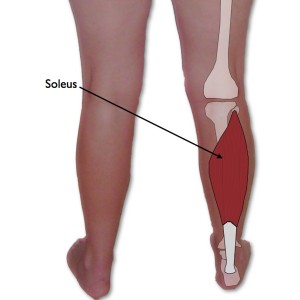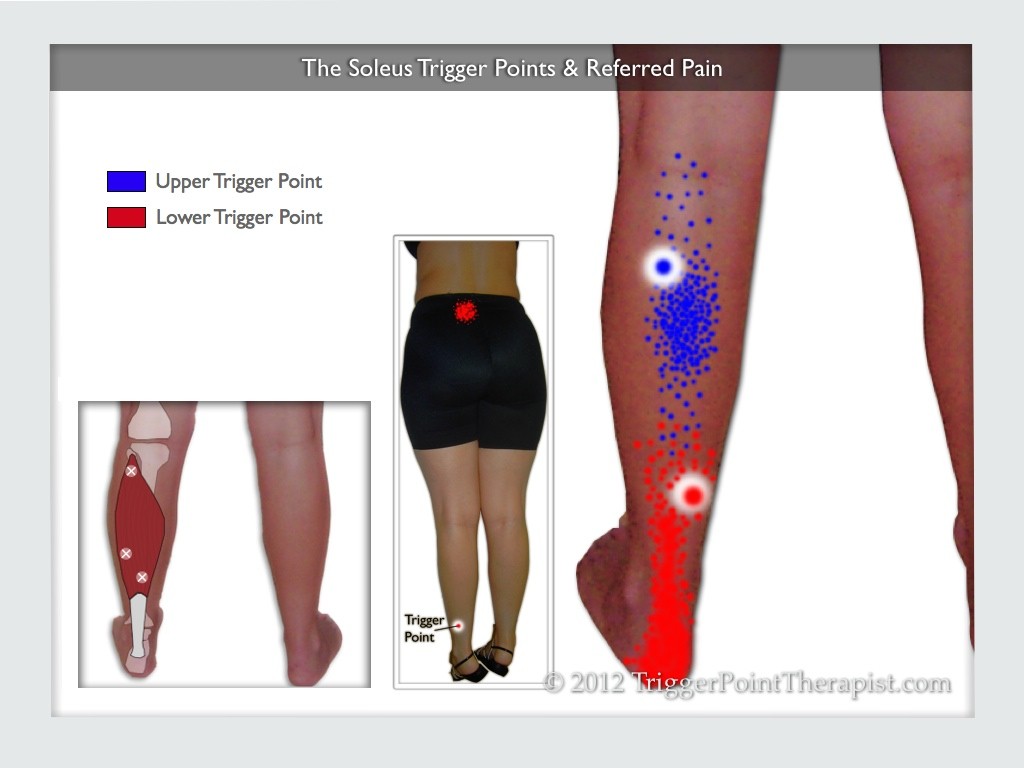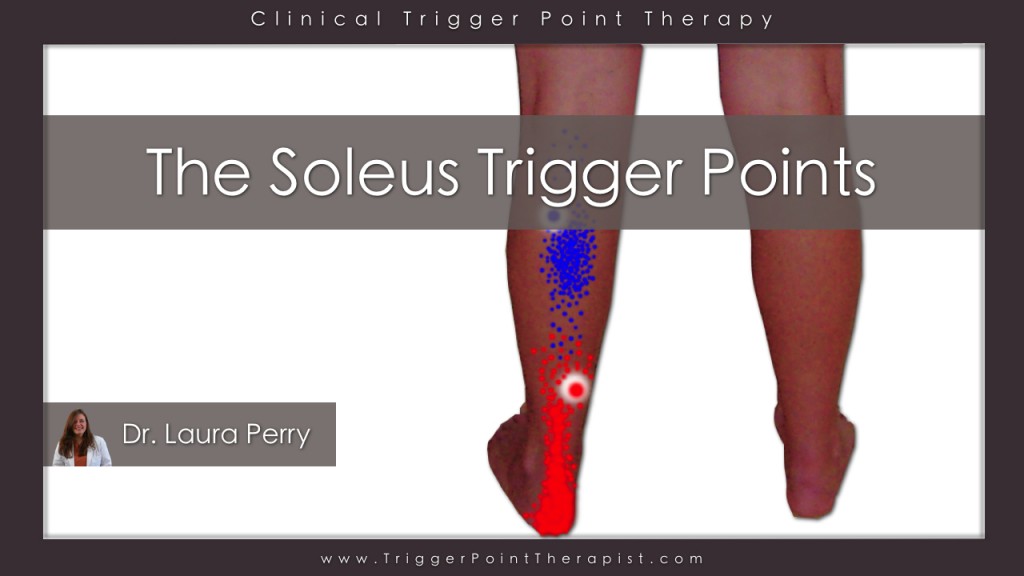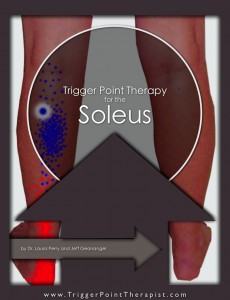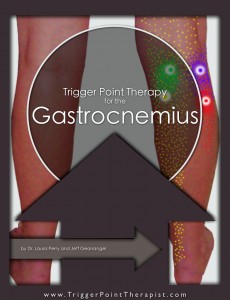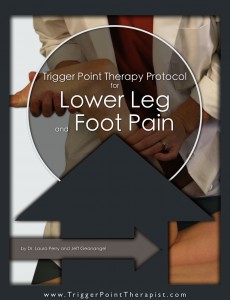The soleus is the wide, flat muscle that covers and shapes the calf region of the lower leg. The “claim to fame” of one of the trigger points in this muscle is the heel pain that many joggers and runners experience during and after exercise. It (along with the tibialis posterior trigger point) can also produce pain the Achilles tendon region as well. Other trigger points in the soleus produce pain and tenderness in the calf region and rarely even way up in the sacroiliac joint of the low back region.
The soleus also acts as a “second heart” pumping venous blood from the legs back up into the trunk. Trigger point activity can compromise this pumping action of the soleus and produce edema or swelling in the lower legs.
Most people are unaware of the amount of muscle tension that builds up in this workhorse muscle. Releasing this tension provides them great , but somewhat unexpected, relief. For this reason, when I have a client that is very tense I will often begin their treatment by releasing the soleus trigger points, even if the pain complaint has nothing to do with their legs.
The Soleus Muscle
Location: The soleus is a large flat muscle that lies beneath the gastrocnemius muscle on the back of the lower leg.
Function: The soleus undergoes a lengthening (eccentric) contraction to control ankle stability during the heel strike phase of walking. It also may contract during the push-off phase if the person is walking fast, jogging, jumping, or running. It also acts as a “second heart” to help push venous blood back up the leg to the trunk.
Muscle Structure: Unlike the gastrocnemius, the soleus muscle does not cross the knee joint. It attaches superiorly to the head of the fibula and along the posterior and medial aspects of the tibia bone. Its fibers extend down the back of the lower leg and join to the Achilles tendon (along with the gastrocnemius muscle fibers) and attach to the calcaneus or heel bone.
The muscle is sandwiched between two sheets of hard fascia to form what is called the “soleus bridge”. This structure surrounds and protects the many blood vessels and nerves that travel down the central canal of the lower leg.
Muscle Actions: Contraction of the soleus produce plantar flexion (downward push) of the foot at the ankle. Unlike the gastrocnemius, the soleus can produce plantar flexion of the foot even if the knee is also flexed. It may also assist with inversion of the foot in some situations.
Synergistic Muscles: The following muscle groups share common biomechanical functionality with the soleus and may become overloaded if it’s unable to perform its workload due to trigger point activity or injury:
- The gastrocnemius and soleus muscles together form the triceps surae muscle group that is the primary plantar flexors of the foot.
- The tibialis posterior and peroneus longus muscles also assist with plantar flexion of the foot.
Antagonistic Muscles: The tibialis anterior and peroneus tertius are the primary dorsiflexors of the foot and may become overloaded if there is trigger point activity in the soleus and other plantar flexors of the foot.
The Soleus Trigger Points
Up to three trigger points can form in this muscle. They are shown in the diagram below.
- The lower trigger point is the most common and is typically found along the inside aspect of the muscle just above where the Achilles tendon becomes palpable.
- The upper trigger point is found in the upper, outside quadrant of the muscle, a few inches below where it attaches to the head of the fibula bone.
- The lateral trigger point is extremely rare, but if present, it is found a few inches superior to the lower trigger point, but along the lateral edge of the muscle.
Soleus Muscle Pain
As shown in the diagram above, the lower trigger point refers pain and tenderness to the heel and Achilles tendon. The upper trigger point in this muscle produces a diffuse pain in the upper calf region. The lateral trigger point may refer a localized pain to the sacro-illiac joint on the same side of the body. It may also contribute to the diffuse pain in the upper calf produced by the upper trigger point.
What Causes Soleus Trigger Points?
The following events or activities may activate or reactivate the soleus trigger points:
- Walking on a slippery surface, especially when the foot slips while trying to push-off with that leg
- Jogging or hiking uphill
- Walking or running in sand
- Wearing shoes or boots with a stiff sole that doesn’t flex at the toes
- Wearing high heel shoes for a prolonged period of time
- Chilling of the muscle group, especially by a ceiling fan or air conditioner while sleeping
- Sleeping on the stomach with the ankles in plantar flexion
- Hanging the feet off (in planter flexion) the foot support of a recliner
- Wearing tight socks or garter
Soleus Trigger Point Symptoms
Clients with active soleus trigger points will present with any or all of the following symptoms or clinical findings:
- Heel pain and tenderness during and after running or jogging.
- Tenderness and pain in the lower Achilles tendon region.
- Unbearable pain when placing bodyweight on the heel.
- Aching of the heel at night, though calf pain and cramps at night are more likely to be caused by gastrocnemius trigger points.
- Upper calf pain and soreness.
- Edema and /or swelling in the ankle and foot (with concurrent calf and foot pain).
- Reduced dorsiflexion of the foot at the ankle, making it difficult for the person to crouch down while standing to pick something up off the floor. The person must bend at the waist to pick something up, causing an overload of the hamstring and low back muscles.
- Walking becomes very difficult, especially up hill or up stairs.
- Soleus trigger points have been shown to contribute to “growing pains” in children.
Related Disorders
- Heel Pain from other Trigger Points: Extreme tenderness of the heel may also be produced by the quadratus plantae muscle found deep in the arch of the foot. The location of this pain and tenderness is typically more anterior than that from the lower soleus trigger point. Also, pain along the inside aspect of the heel only may be produced by a trigger point in the adductor hallucis muscle.
- Achilles Tendonitis: Runners are often diagnosed with this condition. Typically it presents as a burning pain in the Achilles tendon region at the beginning of a run that dissipates gradually, only to return strongly after the run is finished. Often the symptoms of this condition are caused by the soleus trigger points, but chronic trigger point activity in both the soleus and gastrocnemius muscles can put too much tensile stress on the Achilles tendon over time, causing damage to it.
- Thrombophlebitis: The calf pain associated with deep vein thrombosis can be very similar to that produced by active soleus trigger points, though other symptoms, such as redness of the skin in the lower leg, are not produced by trigger point activity. This condition must be diagnosed with a contrast venography study.
- Heel Spur: Radiological evidence of the presence of a heel spur does not necessarily mean that it is the cause of a heel pain complaint. The vast majority of heel spurs produce no symptoms at all. Doctors often attribute heel pain to a spur when the patient has an asymptomatic heel spur on the other foot.
- Shin Splits: This condition is usually described as a chronic pain along the front and/or inside of the lower leg that is related to over-exercise. Chronic tension in the soleus (and other muscles) can cause a stress reaction in the bone surface where the muscle’s tendon attaches to the bone. If the soleus muscle is involved with this condition there will be exquisite tenderness along the medial aspect of the lower half of the Tibia bone.
Treatment of Soleus Trigger Points
For more information on these trigger points and complete step-by-step instructions for locating and releasing the soleus trigger points please purchase the Trigger Point Therapy for Soleus Video + PDF Booklet.
You can watch a sample from the Soleus Trigger Points video on YouTube by clicking on the video image below:
Related Articles:
- Gastrocnemius Trigger Points: The Calf Cramp Trigger Points
- The Peroneal Trigger Points: An Overlooked Source of Ankle Pain
Related Instructional Videos:
